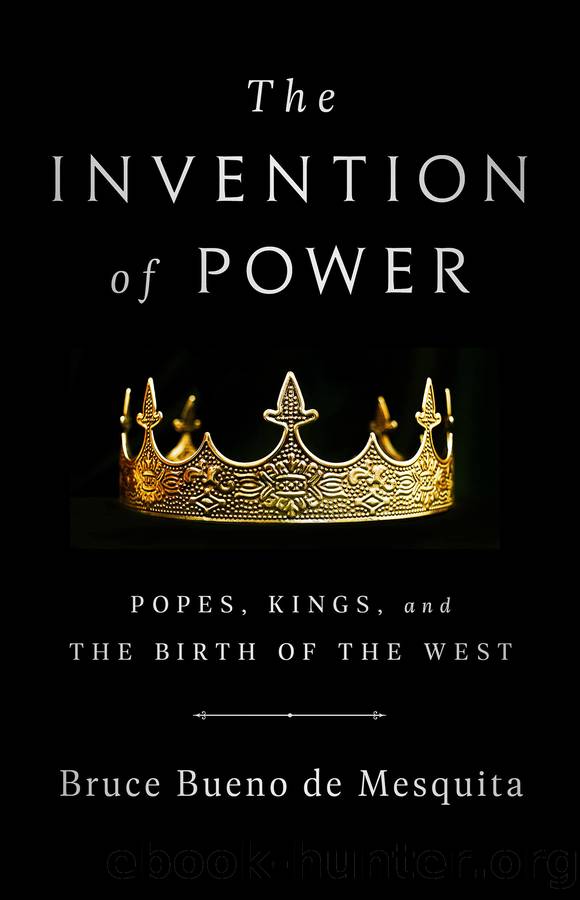The Invention of Power by Bruce Bueno de Mesquita

Author:Bruce Bueno de Mesquita [Bruce Bueno de Mesquita]
Language: eng
Format: epub, azw3
Publisher: PublicAffairs
Published: 2022-01-18T00:00:00+00:00
Unlike our investigation of the decision to nominate and choose a secular or religious bishop, here we can and should look more deeply into the impact of secularly oriented or religiously oriented bishops, since now we are interested in their impact on future economic performance. A bishopâs impact, of course, should depend on whether he was inclined to follow the kingâs policies or the popeâs. But it should also depend on how long he was in office, since a bishop who lasted for only a few months or even only a year or two could not have had the same policy impact as one who dominated his diocese, whether as a prochurch or a proking bishop, for many years. Hence, I now define the secularism of dioceses in each quarter century as the average percentage of the time they were governed by secularly aligned bishops. This way I extend the earlier estimate of whether a chosen bishop was expected to be aligned with the lay leader or with the church by treating every year the bishop was in office as either secular, if the bishop was the secular type, or as religious, if the bishop was the religious type. Of course, the cost indicatorâdistance from Romeâdoes not change over time, but the degree of diocesan secularism or religiosity does.
Figure 5.5 supports the implications of the concordat game for shifting incentives regarding economic growth. The impact of secularism on economic expansion during the period of the concordats is substantively (and statistically) very strong. First, the economic growth graphed by the black bar for far-from-Rome secular bishoprics during the Worms interlude towers over all the other bars in the figure. These sees grew economically much more than any other category of diocesan locales. Second, we see that greater proximity to Rome by itself decreased economic expansion, while greater distance from Rome increased it. Thus we see that the second-largest growth occurred where the churchâs reach was weakest, far from Rome, even when the appointed bishop was expected to be aligned with the pope. Leaders presumably wanted to strengthen themselves wherever they could. Being far from Rome greatly helped in advancing that ambition, and being close to Rome, being easily punished by the pope, did not. Finally, we see that secularism in the years before and the years after the concordat (and before the Protestant Reformation) did not support economic growth, and neither did religious alignment when compared to secular, distant dioceses. Growth was most clearly focused primarily in distant secular sees during the interlude of the concordats.
Unfortunately, we cannot say whether the evidence in Figure 5.5 means that secular bishops stimulated growth or that growth attracted secular bishops. It is too difficult to separate the temporal sequence of change with the information that is available. But both directions are consistent with the concordat gameâs implication that wealth enhanced secularism and secularism enhanced wealth. According to the game, kings always wanted more wealth, as it gave them more power. Hence, during the period
Download
The Invention of Power by Bruce Bueno de Mesquita.azw3
This site does not store any files on its server. We only index and link to content provided by other sites. Please contact the content providers to delete copyright contents if any and email us, we'll remove relevant links or contents immediately.
Harry Potter and the Goblet Of Fire by J.K. Rowling(3045)
Never by Ken Follett(2880)
Shadow of Night by Deborah Harkness(2718)
Ogilvy on Advertising by David Ogilvy(2682)
Zero to IPO: Over $1 Trillion of Actionable Advice from the World's Most Successful Entrepreneurs by Frederic Kerrest(2395)
The Man Who Died Twice by Richard Osman(2299)
Machine Learning at Scale with H2O by Gregory Keys | David Whiting(2291)
Book of Life by Deborah Harkness(2263)
How Proust Can Change Your Life by Alain De Botton(2261)
My Brilliant Friend by Elena Ferrante(2223)
0041152001443424520 .pdf by Unknown(2220)
The Tipping Point by Malcolm Gladwell(2204)
How to Pay Zero Taxes, 2018 by Jeff A. Schnepper(2099)
Will by Will Smith(2042)
Purple Hibiscus by Chimamanda Ngozi Adichie(1981)
Hooked: A Dark, Contemporary Romance (Never After Series) by Emily McIntire(1959)
Borders by unknow(1785)
Rationality by Steven Pinker(1765)
Daughter of Smoke and Bone by Laini Taylor(1744)
